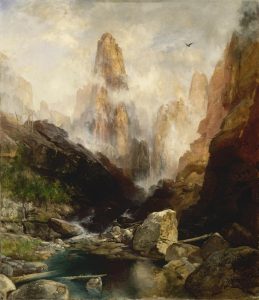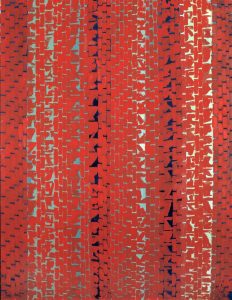UMFA Unveils Smithsonian Art Loans
Diego Rivera (Mexican, 1886–1957), La ofrenda, 1931, oil on canvas, 48 ¾ x 60 ½ in., Art Bridges. ©2019 Banco de México Diego Rivera Frida Kahlo Museums Trust, Mexico, D.F. / Artists Rights Society (ARS), New York. Photo: 2017 Christie’s Images Limited.
October 26, 2019
The Utah Museum of Fine Arts showcases some of the finest pieces of modern art in recent decades. Most of their exhibits are conversation-starters, catalysts for connecting art to the local community. Their latest exhibition is no different — consisting of four incredible paintings all of which are loans from the Smithsonian American Art Museum and Art Bridges Foundation. The journey of these paintings to our campus is a long one, but one that reveals a behind-the-scenes story.
The story for three of these loaned works start in Washington D.C., the home of the Smithsonian American Art Museum. Stephanie Stebich, the director of SAAM, had a vision for the 44,000 pieces of art (dubbed “objects”) within the museum walls. On average, only 3% of a museum’s object collection is showcased at a time. Instead of letting these objects — showcased or stored — remain selfishly upon only their walls, they wanted to share their masterpieces with as many people as possible. Aside from this main idea, they wanted to encapsulate a national diversity of artwork on walls across the country — and this is how American West Consortium came to life. This partnership provided UMFA with three new paintings from Thomas Moran, Georgia O’Keeffe and Alma Thomas, which are on loan from the SAAM collection.
Art Bridges was founded by art donors with a vision to recruit art museums around the nation in establishing a nation-wide, multi-institutional and multi-year partnership. The first actions of this plan culminated in phase one. This new partnership provided the UMFA with a Diego Rivera painting from its own collection.
“Art Bridges is really a simple, but powerful concept,” Stebich said. “We were looking for art-rich institutions, which we call catalyst museums. We were looking for museums where the artwork would have the most impact on the community.”
Museums around the country were visited individually and hand-picked by the Art Bridges + Terra Foundation Initiative. Founding and starting this coalition was not only an intense task but one that required the minds and efforts of many. “This was a full faculty effort,” Stebich said.

After the long process, ultimately five final museums in the West were chosen — the UMFA among them. These museums are now the founders of the American West Consortium. With the UMFA already receiving prestigious recognition across the nation, it’s no surprise they were chosen to be a part of this program. “The UMFA is a flagship museum for the city, state and university,” Stebich said.
This initiative is merely the first phase of four planned. The next phases haven’t been fully revealed yet — only that phase two will be coming by 2023. The important takeaway for the UMFA and art enthusiasts alike is, “Amazing works have more value when they are being shared,” Stebich said.
Each painting was chosen for a specific purpose, with the hope to give a unique impact on the community. These paintings deal with political, personal or societal aspects of the American lifestyle. The messages behind the pieces are essentially timeless. The paintings chosen are from the world-renowned artists Alma Thomas, Diego Rivera, Thomas Moran and Georgia O’Keeffe. Not all of these names would be familiar to the average person, but each painting reflects a narrative and adversity from the artist.
It’s not hard to see why Thomas Moran’s 1875, “Mist in Kanab Canyon,” would fit so well on the UMFA’s walls. Moran’s journey to Utah, however, was cut short due to difficult transportation through Kanab Canyon. Although he never made it to the spot he painted, he finished an idealized version of it based on his sketches and photographs. He went on to create many paintings in his idealization style of the American West from his New York studio.
The remaining three artists all faced more contemporary issues of their own. The theme of these phase one paintings revisited American artists who were often overlooked because of their race or gender. O’Keeffe, Rivera and Thomas all faced discrimination based on social standards of the early 20th century.

O’Keeffe’s painting “Manhattan”, reflects her personal struggles with being a teetering abstraction artist in a male-dominated field. She emphasized this with her abstract cityscape while featuring florals and a bright color palette.
Rivera’s painting, “La Ofrenda” celebrates his Mexican-American culture in his painting depiction of altars being erected, to bring offerings to deceased loved ones. This practice is found in Mexican tradition and their well-known holiday Dia de Los Muertos. He was well known as a champion for Mexican culture and themes of justice and revolution.
Thomas’s work, “Red Sunset Old Pond Concerto”, was barely known in her time. Although it’s up to the viewer to interpret this geometric piece, to me, it’s obvious she’s depicting some time and place in her life — a place of pure bliss. The unusual acrylic medium and three-colored abstraction perform a concerto of the sun reflecting on the water. There was creative bravery in her expression. As an African-American woman and artist, this was reflected in her work. She went onto be the first woman of color to become a part of the Washington Colors School, a movement of nationally-touring artists based out of Washington D.C.
These artists’ passions and beliefs are reflected in their beautiful work. All of them were inspired to question and highlight artistic ideals. They did this by using their personal experiences and their art to create a narrative to reflect life in America. These paintings convey such messages using styles of teetering abstraction, post-abstract expressionism and idealism.
Thanks to SAAM and Art Bridges, the UMFA is one of many museums across the country to share works of such magnitude with more people. Don’t miss your chance to witness them in person. These paintings will be at the UMFA until Oct. 4, 2020.
This article has been updated to clarify the separate roles of the Smithsonian American Art Museum and Art Bridges. A previous version of this article inaccurately implied that UMFA’s collaboration with Art Bridges provided all four paintings. We regret the error.








